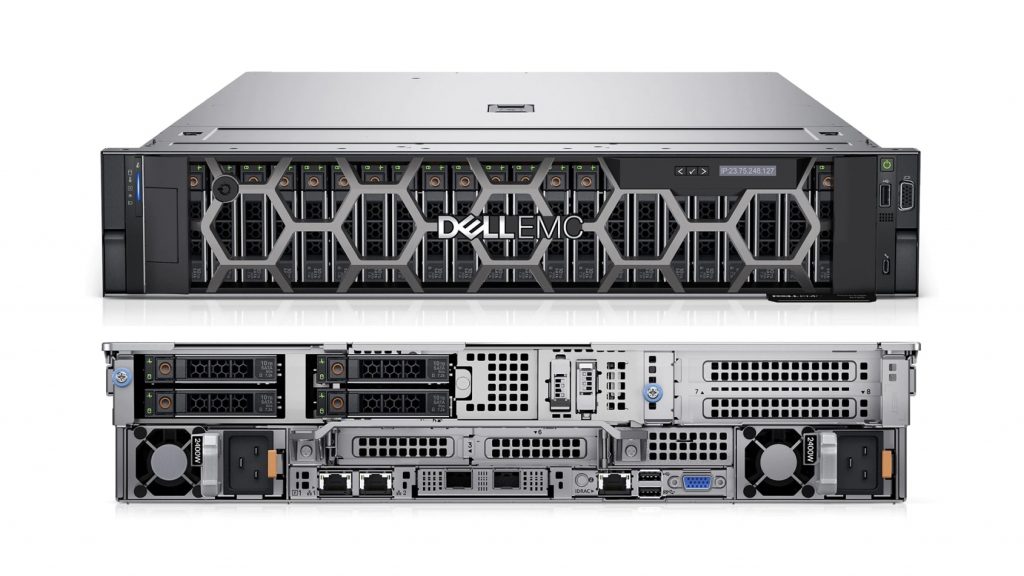Which Dell server model is best for virtualization?
For virtualization workloads, the Dell PowerEdge R750 stands out as the best overall Dell server model, combining cutting-edge performance, scalability, and VMware/Hyper-V optimization.

Below is a detailed analysis of its strengths and how it compares to other Dell models:
1. Dell PowerEdge R750: The Gold Standard for Virtualization
Key Features
Processors: Supports up to 2x 3rd Gen Intel Xeon Scalable processors (up to 40 cores/processor), delivering 1.53x better performance than previous generations for virtual machines (VMs) .
Memory: Up to 8 TB DDR4-3200 (using LRDIMMs) or 1 TB of Intel Optane Persistent Memory for high-throughput applications like vSAN or database VMs; 32 DIMM slots allow granular scaling for memory-intensive VMs.
Storage: 24x 2.5" drives (SAS/SATA/NVMe) with optional 8x NVMe drives in the backplane, enabling high I/O for virtual desktop infrastructure (VDI) or hyperconverged clusters; Supports BOSS-S2 for boot-from-SAN redundancy.
I/O & Networking: 8x PCIe Gen4 slots for GPUs (e.g., NVIDIA A100) or 100GbE adapters; Built-in OCP 3.0 Mezzanine slot for flexible networking (e.g., RDMA for VSAN).
Management: iDRAC 9 with Lifecycle Controller for automated VM deployment and firmware updates. Certified for VMware vSphere 8 and Windows Server 2025, ensuring seamless integration with modern hypervisors.
Why It’s Ideal for Virtualization
Performance: Achieves vmmark 3.1 scores exceeding 20,000 points, outperforming previous-gen servers by 37% in latency-sensitive workloads like real-time analytics.
Scalability: Easily scales from 20 to 200+ VMs by adding CPUs, memory, or storage; Modular design supports future upgrades to 4th Gen Intel Xeon processors.
Energy Efficiency: Dynamic Power Saving Mode reduces idle power consumption by 25% compared to older models; Optional Direct Contact Liquid Cooling (DCLC) lowers cooling costs by 40% in dense environments.
Use Cases
Large-Scale Virtualization: Hosts 100+ VMs for enterprise applications (e.g., SAP, Exchange). Hyperconverged Infrastructure (HCI): Optimized for VMware vSAN and Nutanix AHV clusters. VDI Deployments: Handles 200+ concurrent virtual desktops with low latency.
2. Dell PowerEdge R750xs: Cost-Optimized Virtualization
Key Features
Processors: Supports 2x 3rd Gen Intel Xeon Silver/Gold processors (up to 32 cores/processor).
Memory: Up to 1 TB DDR4-3200 (16 DIMM slots), ideal for budget-conscious environments; No support for LRDIMMs or Optane Persistent Memory.
Storage: 24x 2.5" drives (SAS/SATA/NVMe) with 8x NVMe direct-attach option for VSAN.
I/O & Networking: 6x PCIe Gen4 slots and built-in 100GbE RoCE for software-defined storage.
Management: Same iDRAC 9 features as the R750.
Why It’s a Strong Alternative
Cost-Effectiveness: Priced 15–20% lower than the R750 for equivalent configurations.
Energy Efficiency: 30% lower power consumption than x86 servers in AI/ML tasks. Supports Dynamic Power Saving Mode for hybrid workloads.
Use Cases
Medium-Scale Virtualization: Hosts 50–100 VMs for SMBs or departmental workloads.
Edge Computing: Ruggedized design for harsh environments (e.g., manufacturing floors).
VSAN Clusters: Optimized for 2-node VMware VSAN deployments with RDMA support.
3. Dell PowerEdge R940: Mission-Critical Virtualization
Key Features
Processors: Supports up to 4x 2nd Gen Intel Xeon Scalable processors (up to 28 cores/processor).
Memory: Up to 6 TB DDR4-2933 (48 DIMM slots), suitable for memory-intensive VMs like SAP HANA. Optional Intel Optane DC Persistent Memory for faster data access.
Storage: 24x 2.5" drives (SAS/SATA/NVMe) with 8x NVMe via PCIe adapters.
I/O & Networking: 14x PCIe Gen3 slots (expandable via risers). Supports NVIDIA V100 GPUs for GPU-accelerated VMs.
Why It’s a Niche Choice
High Availability: 99.9999% uptime with redundant power supplies and hot-swappable components. Ideal for financial transactions or healthcare systems where downtime is catastrophic.
Legacy Workloads: Backward compatibility with older PCIe Gen3 devices.
Use Cases
Mission-Critical Applications: Hosts databases (e.g., Oracle, SQL Server) with zero tolerance for downtime.
High-Performance Computing (HPC): Runs AI/ML workloads requiring massive parallel processing.
4. Dell PowerEdge R650xs: Dense Virtualization for Edge Environments
Key Features
Form Factor: 1U rack server with 10x 2.5" drives (SAS/SATA/NVMe).
Processors: Supports 2x 3rd Gen Intel Xeon Silver/Gold processors (up to 32 cores/processor).
Memory: Up to 1 TB DDR4-3200 (16 DIMM slots).
I/O & Networking:4x PCIe Gen4 slots and 100GbE RoCE for edge-to-cloud connectivity.
Management: iDRAC 9 with predictive failure analysis.
Why It’s Unique
Space Efficiency: Fits in compact data centers or remote offices. Supports VSAN ReadyNodes for hyperconverged edge deployments.
Energy Efficiency: 20% lower power consumption than previous-gen 1U servers.
Use Cases
Edge Virtualization: Hosts VMs for retail POS systems or industrial IoT gateways.
VDI at the Edge: Delivers virtual desktops to remote workers with low latency.
Key Considerations for Selection
Workload Size:
Small/Medium: R750xs (cost-effective) or R650xs (edge).
Large/Enterprise: R750 (scalable) or R940 (mission-critical).
Budget:
Tight Budget: R750xs (15–20% cheaper than R750).
Unlimited Budget: R940 (high availability) or R750 (future-proof).
Scalability:
R750 allows seamless upgrades to 4th Gen Intel Xeon processors and 12 TB memory.
R750xs has fixed CPU/core limits (32 cores/processor).
Hypervisor Compatibility:
All models are certified for VMware vSphere, Microsoft Hyper-V, and Red Hat KVM.
R750/R750xs offer native support for VMware vSAN 8 and Azure Stack HCI.
Final Recommendation
For most organizations, the Dell PowerEdge R750 is the best overall choice for virtualization due to its unmatched balance of performance, scalability, and energy efficiency. It excels in large-scale VDI, hyperconverged clusters, and modern workloads like AI/ML. The R750xs is ideal for cost-sensitive environments or edge deployments, while the R940 caters to mission-critical applications. Always prioritize the R750 for future-proofing and seamless integration with next-gen technologies like Windows Server 2025 and VMware vSphere 8.



